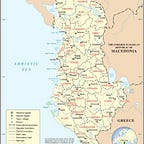The demographic decline of the Orthodox population in Albania
Albania is known for its religious diversity, which includes a significant Orthodox population. By the early 20th century, Albania had a religious composition of 70% Muslim, 20% Orthodox, and 10% Catholic. However, the 2011 census revealed that the Orthodox population in Albania had declined to just 6.75%, a significant drop from the 20% reported in the 1927 census. Many were skeptical of this drastic decline, as their perceptions of the population were based on the 1927 census.
However, the decline is real and can be attributed to a fall in fertility, a higher emigration rate, as well as secularization. The decline in fertility was more pronounced among the Orthodox population compared to other groups, primarily due to higher literacy rates, especially among females. Emigration had been prevalent among Orthodox Albanians before 1945, but it became even more significant after the fall of the communist regime in 1990. Secularization also played a role in the decline, although it was not as significant as the other factors. This blog will delve deeper into each of these three factors using data from microdata as well as the civil registry.
Fertility decline
While we don’t possess fertility rate data from before 1960, we are able to reconstruct fertility differences by religious groups by using the 2011 census microdata provided by INSTAT (the Albanian Institute of Statistics).
These differences are inextricably linked to the educational level. The graph below also shows the level of education for women by age and religious group in 2011.
Nonetheless, the fertility rate differences can be observed even within the same educational level, hinting perhaps at deeper cultural differences.
Emigration
Emigration has been a longstanding tradition among the Orthodox population in Albania, even before 1945. The Orthodox Albanians were historically more likely to emigrate compared to other groups, seeking better economic and political opportunities elsewhere. They constituted most of the Albanian diaspora in various countries, including the United States, Egypt, and Romania. The relatively unknown census of 1945 showed that the share of the Orthodox population had declined to 17.2% compared to 20% in 1927, partially due to emigration.
However, the bulk of the emigration happened after the fall of the communist regime in 1991 and the opening of the borders. A large percentage of the Orthodox population, especially so among the Greek minority, migrated to Greece. Other segments of this population migrated to Italy, North America, and other Western countries. This exodus happened among all Albanians, but it was even more pronounced among the Orthodox. Civil registry shows us the percentage born outside Albania after 1990 by religious group.
We can decompose the Orthodox population in ethnic groups.
Secularization
Another contributing factor in the decline of the Orthodox population is secularization. This phenomenon has touched the Muslim population more profoundly, but it has had its effects on the Orthodox as well. One of the main mechanisms for this have been interreligious marriages. In Albania, most of the marriages between people of different religious backgrounds have been between Orthodox and Muslims (usually Bektashi). The children born from these marriages tend to be less religious than those born in households where both parents belong to the same religious denomination.
The graph shows that by the late 2000s, nearly half of people of Orthodox background were marrying outside their denominational group.
However, one factor working contrary to this phenomenon was emigration to Greece, where being Orthodox Christian was prized. This led to higher prestige for the Orthodox religion, and an increase in names of Greek and Orthodox extraction after 1990.
However, the years after 2000 show stagnation and decline in such names, and further evidence shows that this became even more accentuated after the Greek financial crisis, after which Greece lost its appeal to Albanians as an emigration destination.
Summary and conclusion
The graph shows in the clearest way possible the demographic trajectory of the Orthodox population based on the civil registry as well as the census microdata. To measure the Orthodox share in the civil registry, we use a comprehensive list of names of Orthodox extraction and link individuals to the name of their oldest patrilineal ancestor born before 1945.
Both the civil registry and the microdata show a decline in Orthodox births during the early 1940s, related to the effects of WW2, as well as a baby boom after 1945 that lasted until the mid 1950s. This was succeeded by the demographic transition of the Orthodox population, which started relatively earlier and in a higher intensity compared to the rest of the Albanian population.
The difference between the red line (all civil registry births) and the blue line (only births in Albania) shows the effects of migration after 1990. The green line tries to approximate the results of the census microdata by excluding the part of the population which was born in Albania but emigrated after 1990. While there is a lot of noise in the census microdata (since it’s just a 3% sample), its trajectory is very similar to the one traced by the civil registry data. The differences between the two lines can be attributed to the effects of secularization.
The Orthodox population in Albania has experienced a decline in numbers similar to other Christian groups in Muslim-majority countries that belonged to the Ottoman Empire. This is due to comparable demographic factors, stemming from a similar socioeconomic development during the late Ottoman period. Nevertheless, the Orthodox population in Albania is more integrated in society and not subjected to the persecution that these other groups face. In the future, their percentage of the population is expected to converge at around 5%, while the continuing practice of exogamous marriages will further secularize them.
